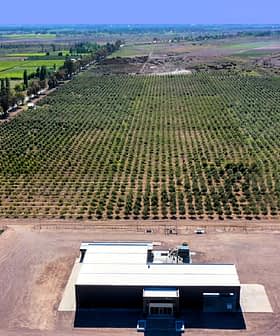New Zealand Olive Oil Producers Set for Record Year
Olive oil production is at a record high in New Zealand with the potential to double in the coming years.
 Olive trees on Waiheke island, New Zealand
Olive trees on Waiheke island, New ZealandOlive harvesting season is in full swing in New Zealand, where producers are expecting a record-setting year.
There have to be good results financially to get more people involved. Passion isn’t enough.
Gayle Sheridan, the executive officer of Olives NZ, attributed the increase to better weather. He also praised a joint effort, which is being led by the association and partially funded by the government, for helping to spur on the growth.
“2018, is looking to be a record year with some record tonnages being reported across the country and especially from the groves following the Focus Grove Project methodologies,” Sheridan said.
David Walshaw is one of the olive farmers taking part in the Focus Grove Project and the author of Olive Oil the New Zealand Way. He has run a small family operation of about 2,300 trees for the past 15 years.
Walshaw praised the Focus Grove Project and said that the implementation of many of their practices, including rotational pruning, allowing trees to grow to be taller, machine-harvesting and spraying protectant on trees, have led to an increase in his olive yields.
“[This] combination has ensured, certainly, that the focus groves and some others have been able to increase their production. My averages have increased considerably,” he said. “This year I ended up with about 38 kilograms [of olives] per tree, which was way higher than I was getting before. I think that result speaks for itself.”
Walshaw harvested 50 tonnes of olives from his trees this year, which was the largest amount yet in his 15-year olive growing career and a considerable improvement from last year’s total of 27 tonnes.
“This is mostly to do with the way we prune and the way we spray protective spray across our trees. We now do that uniformly across many groves,” he said. “The high performing groves, which mine would be regarded to be, would have nowhere near the same production if we weren’t spraying for protection against disease.”
New Zealand produced about 184 tonnes of olive oil last year, almost all of which was graded as extra virgin. Sheridan expects that figure to be much larger this year but does not have any official production estimates yet.
“This is a great result following on from 2017 when 40 percent of olive groves across the country had no harvest because of weather events,” he said.
Walshaw agreed that unusual weather affected olive yields, but said that last year was also an off-year for many growers in New Zealand, and that affected yields as well. As a result, he expects to have another down year in 2019 but thinks it will not be quite as bad as it was in 2017.
“We are gradually getting our production up and the production for the different trees is getting more uniform,” he said. “[But] I expect we will have a down year next year.”
Even as production continues to fluctuate between on and off years, olive oil consumption remains steady. The average New Zealander consumes about one liter of olive oil per annum, according to research released by Olives NZ in May.
“[Consumption will] probably remain pretty static, but extra virgin olive oil is by far the main oil used,” Sheridan said. “Olives NZ’s latest research has shown that 75 percent of consumers use olive oil, albeit maybe not exclusively.”
One of the main challenges in New Zealand is continuing to increase production in order to lessen the country’s dependence on imports. POne of the obstacles in doing so is getting started, which requires a large investment of time and capital up front with modest returns.
“Returns aren’t huge and one has to be well organized in the growing and marketing to make any reasonable income,” Walshaw said. “And that income doesn’t happen for the first 10 or 12 years, I suspect.”
New Zealand currently produces less than 10 percent of the extra virgin olive oil that is consumed there.
“However, [we have] the potential to at least double that by improving productivity,” Sheridan said. A production increase could also boost the country’s fledgling export market, which makes up about 10 percent of its production, and almost all of which is destined for Japan.
“While exporting is a niche area for some large growers, the best opportunity is to increase local consumption of New Zealand extra virgin olive oil,” Sheridan added.
Many of New Zealand’s current producers are driven by their passion for olive oil, but Walshaw said that is not enough to make up for poor financial performance by the crop. Even so, he is optimistic about the future as foreign judges continue to praise the quality of New Zealand olive oils.
“I think the sector will continue to grow, but in the end to get a large enough economy, there have to be good results financially to get more people involved,” he said. “Passion isn’t enough.”








